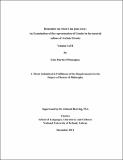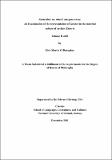| dc.contributor.advisor | Herring, Edward | |
| dc.contributor.author | O'Donoghue, Eoin | |
| dc.date.accessioned | 2012-05-03T11:38:58Z | |
| dc.date.available | 2015-11-20T10:33:36Z | |
| dc.date.issued | 2012-12-22 | |
| dc.identifier.uri | http://hdl.handle.net/10379/2725 | |
| dc.description.abstract | The study of the lives of men and women in ancient Greece and Rome has long
attracted scholarly attention and much good work has been done on these topics.
However, there has been a comparative neglect of the study of gender identities in
the world of the Etruscans. It is the purpose of this thesis to partially rectify this
situation through an examination of the gender identities of men and women from
Archaic Etruria (c. 600-450 BC).
Unlike most previous scholarship on gender the approach employed here is
not grounded in feminist thought, instead the aim is to seek to analyse the differences
in the roles, activities and identities of men and women during this time. The
apparent power of Etruscan women is carefully analysed, it is shown that while they
had many significant public roles and duties, these were performed within the
framework of a hegemonic masculine society. The public and private identities of
men are examined within their social and political environment. The evidence for
this analysis is primarily artistic. As well as explaining the respective roles of men
and women the evidence is considered, where possible, in its regional and historical
setting. | en_US |
| dc.rights | Attribution-NonCommercial-NoDerivs 3.0 Ireland | |
| dc.rights.uri | https://creativecommons.org/licenses/by-nc-nd/3.0/ie/ | |
| dc.subject | Etruscans | en_US |
| dc.subject | Etruria | en_US |
| dc.subject | Gender identities | en_US |
| dc.subject | Ancient art | en_US |
| dc.subject | Classics | en_US |
| dc.title | Remember me when I am gone away: An Examination of the Representation of Gender in the Material Culture of Archaic Etruria | en_US |
| dc.type | Thesis | en_US |
| dc.contributor.funder | College of Arts, Celtic Studies and Social Sciences, NUI Galway | en_US |
| dc.local.note | This thesis considered how men and women living in central Italy in the 6th century BC lived their lives and their conception of what it was to be male and female. | en_US |
| dc.local.final | Yes | en_US |
| nui.item.downloads | 2 | |



